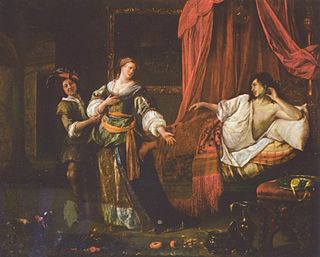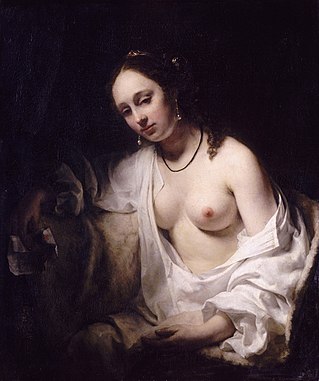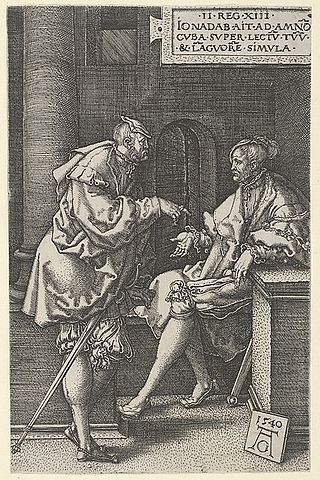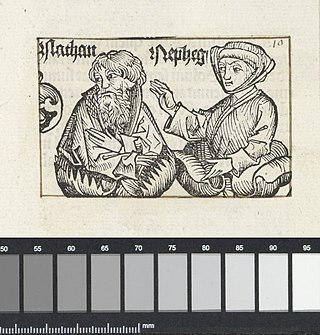
Absalom was the third son of David, King of Israel with Maacah, daughter of Talmai, King of Geshur.

Amnon was, in the Hebrew Bible, the oldest son of King David and his second wife, Ahinoam of Jezreel. He was born in Hebron during his father's reign in Judah. He was the heir apparent to the throne of Israel until he was assassinated by his half-brother Absalom to avenge the rape of Absalom's sister Tamar.

The Book of Samuel is a book in the Hebrew Bible, found as two books in the Old Testament. The book is part of the Deuteronomistic history, a series of books that constitute a theological history of the Israelites and that aim to explain God's law for Israel under the guidance of the prophets.

David was, according to the Hebrew Bible, the third king of the United Kingdom of Israel.
According to 2 Samuel, Adonijah was the fourth son of King David. His mother was Haggith as recorded in the book of 2 Samuel 3:4. Adonijah was born at Hebron during the long conflict between David and the House of Saul. In 1 Kings, he briefly proclaimed himself king of Israel during the terminal illness of his father David, before peacefully ceding the throne to his brother Solomon.

Bathsheba was the wife of Uriah the Hittite and later of David, according to the Hebrew Bible. She was the mother of Solomon, who succeeded David as king, making her the Gebirah. She is best known for the Biblical narrative in which she was summoned by King David, who had seen her bathing and lusted after her.
Incest in the Bible refers to sexual relations between certain close kinship relationships which are prohibited by the Hebrew Bible. These prohibitions are found predominantly in Leviticus 18:7–18 and 20:11–21, but also in Deuteronomy. Jewish views on incest are based on the biblical categories of forbidden relationships and have been subject to rabbinic interpretations in the Talmud. The Karaites reject the authority of Talmudic opinions and interpret the biblical prohibitions differently. The various Christian denominations set their own categories of prohibited incestuous relationships, which have changed from time to time. The laws of many countries regarding prohibited relationships do not necessarily follow the biblical prohibitions nor those of any particular church.

Jonadab is a figure in the Hebrew Bible, appearing in 2 Samuel 13. He is described in verse 3 as the son of Shimeah, who was the brother of David, making Jonadab a cousin to Amnon as well as his friend. He is called "very wise", usually translated as "very shrewd" (NIV) or "very crafty" (ESV).

King David is a 1985 American Biblical epic film about the life of David, the second King of the Kingdom of Israel, as recounted in the Hebrew Bible. The film is directed by Bruce Beresford, written by Andrew Birkin and James Costigan, and stars Richard Gere in the title role. The ensemble cast includes Edward Woodward, Alice Krige, Denis Quilley, Cherie Lunghi, Hurd Hatfield, John Castle, Jean-Marc Barr, Christopher Malcolm, and Gina Bellman.

Nathan was the third of four sons born to King David and Bathsheba in Jerusalem. He was a younger brother of Shammuah and Shobab, and an older brother to Solomon. Although Nathan is the third son raised by David and Bathsheba, he is the fourth born to Bathsheba. The first son died before he could be named.
Sex is considered repeatedly in the Hebrew Bible. Some references provide unambiguous ethical regulations, such as the laws given in Leviticus or Deuteronomy. Others are more ambivalent, most famously the potentially homosexual actions of Ham with his father, Noah. Its depictions of homosexuality, rape, prostitution and incest have spurred considerable academic and theological attention.

Women in the Bible are wives, mothers and daughters, servants, slaves and prostitutes. As both victors and victims, some women in the Bible change the course of important events while others are powerless to affect even their own destinies. The majority of women in the Bible are anonymous and unnamed. Individual portraits of various women in the Bible show women in a variety of roles. The New Testament refers to a number of women in Jesus' inner circle, and he is generally seen by scholars as dealing with women with respect and even equality.
Talmai is a name in the Bible referring to a number of minor people. Its Aramaic version was associated with the Greek Ptolemy, and is the origin of Bartholomew.

The sons of King David are mentioned both as a group and individually several times in the biblical accounts of the reigns both of David and his successor Solomon.
The Hebrew Bible contains a number of references to rape and other forms of sexual violence, both in the Law of Moses, its historical narratives and its prophetic poetry.

2 Samuel 13 is the thirteenth chapter of the Second Book of Samuel in the Old Testament of the Christian Bible or the second part of Books of Samuel in the Hebrew Bible. According to Jewish tradition the book was attributed to the prophet Samuel, with additions by the prophets Gad and Nathan, but modern scholars view it as a composition of a number of independent texts of various ages from c. 630–540 BCE. This chapter contains the account of David's reign in Jerusalem. This is within a section comprising 2 Samuel 9–20 and continued to 1 Kings 1–2 which deal with the power struggles among David's sons to succeed David's throne until 'the kingdom was established in the hand of Solomon'.
Tamar is an epic poem by the American writer Robinson Jeffers, first published in 1924. A tale of incest and violence, it follows Tamar Cauldwell, the daughter of a Californian ranch family, as she experiences transgression, hatred, and destruction. Tamar was the first unrhymed narrative poem Jeffers wrote. The story makes references to the biblical Books of Samuel and deals with themes of nature and corruption.

1 Kings 1 is the first chapter of the Books of Kings in the Hebrew Bible or the First Book of Kings in the Old Testament of the Christian Bible. The book is a compilation of various annals recording the acts of the kings of Israel and Judah by a Deuteronomic compiler in the seventh century BCE, with a supplement added in the sixth century BCE. This chapter belongs to the section focusing on the reign of Solomon over the unified kingdom of Judah and Israel. The focus of this chapter is the reign of David and Solomon, the kings of Israel.

2 Samuel 14 is the fourteenth chapter of the Second Book of Samuel in the Old Testament of the Christian Bible or the second part of Books of Samuel in the Hebrew Bible. According to Jewish tradition the book was attributed to the prophet Samuel, with additions by the prophets Gad and Nathan, but modern scholars view it as a composition of a number of independent texts of various ages from c. 630–540 BCE. This chapter contains the account of David's reign in Jerusalem. This is within a section comprising 2 Samuel 9–20 and continued to 1 Kings 1–2 which deal with the power struggles among David's sons to succeed David's throne until 'the kingdom was established in the hand of Solomon'.














